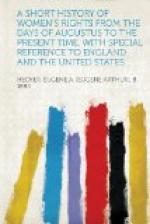The subjects studied followed the orthodox views. Beginning with the reign of Queen Anne boarding-schools for girls became very numerous. At these schools “young Gentlewomen” were “soberly educated” and “taught all sorts of learning fit for young Gentlewomen.” The “learning fit for young Gentlewomen” comprised “the Needle, Dancing, and the French tongue; a little Music on the Harpsichord or Spinet, to read, write, and cast accounts in a small way.” Dancing was the all-important study, since this was the surest route to their Promised Land, matrimony. The study of French consisted in learning parrot-like a modicum of that language pronounced according to the fancy of the speaker. As, however, the young beau probably did not know any more himself, the end justified the means. Studies like history, when pursued, were taken in homoeopathic doses from small compendiums; and it was adequate to know that Charlemagne lived somewhere in Europe about a thousand or so years ago. Yet even this was rather advanced work and exposed the woman to be damned by the report that she was educated. Ability to cook was not despised and pastry schools were not uncommon. Thus in the time of Queen Anne appears this: “To all Young Ladies: at Edw. Kidder’s Pastry School in little Lincoln’s Inn Fields are taught all Sorts of Pastry and Cookery, Dutch hollow works, and Butter Works,” etc.
At last in the first decades of the nineteenth century the civilised world began slowly to take some thought of women’s higher education and to wake up to the fact that because a certain system has been in vogue since created man does not necessarily mean that it is the right one; a very heretical and revolutionary idea, which has always been and still is ably opposed by that great host of people who have steadily maintained that when men and women once begin to think for themselves society must inevitably run to ruin. In 1843 there was established a certain Governesses’ Benevolent Institution. This was in its inception a society to afford relief to governesses, i.e., women engaged in tutoring, who might be temporarily in straits, and to raise annuities for those who were past doing work. Obviously this would suggest the question of what a competent governess was; and this in turn led to the demand for a diploma as a warrant of efficiency. That called attention to the extreme ignorance of the members of the profession; and it was soon felt that classes of instruction were needed. A sum of money was accordingly collected in 1846 and given the Institution for that purpose. Some eminent professors of King’s College volunteered to lecture; and so, on a small scale to be sure, began what is now Queen’s College, the first college for women in England, incorporated by Royal Charter in 1853. In 1849 Bedford College for women had been founded in London through the unselfish labours of Mrs. Reid; but it did not receive its charter until 1869. Within a decade Cheltenham, Girton, Newnham, and other colleges for women had arisen. Eight of the ten men’s universities of Great Britain now allow examinations and degrees to women also; Oxford and Cambridge do not.




